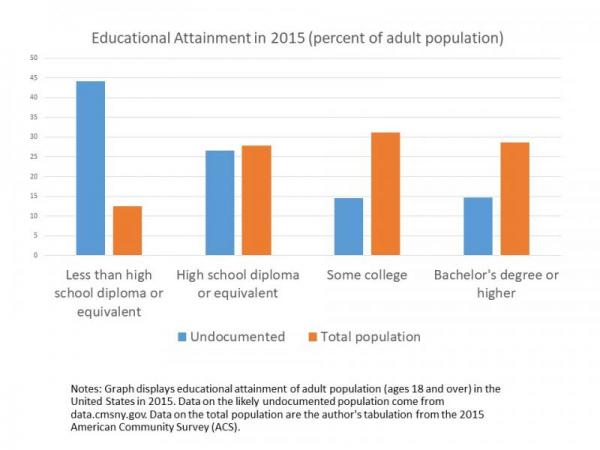Undocumented Students and Higher Education
By Annie Laurie Hines, UC Davis
Over 11 million undocumented immigrants reside in the United States. Many arrived as children, attended school in the U.S. and consider the country their home. Over 60 percent of the undocumented population has lived in the U.S. for 10 years or more. However, undocumented students face substantial barriers to higher education due to their legal status. This brief outlines key facts about the barriers undocumented students face in terms of access to higher education.
Undocumented families live in poverty at higher rates than the U.S.-born.
The Pew Hispanic Center estimates that one third of children in families with undocumented parents lived in poverty.[2] Also, in 2015, 24.5 percent of the undocumented population lived below the poverty threshold and over half lacked health insurance coverage.[3]
A large number of undocumented immigrants is of college-going ages.
According to estimates from the Center for Migration Studies, there are over 1.2 million undocumented immigrants between the ages of 18 and 24.[3]
Undocumented students often have low incomes and may also lack access to the usual resources that assist low income college students.
Undocumented students are not eligible for federal financial aid, and they are not uniformly eligible for in-state tuition due to legislation passed in 1996 that prohibited states from providing benefits to undocumented immigrants that were not available to U.S. citizens.[4] Some states, including California and Texas, have found ways to provide reduced tuition to undocumented students by using other criteria. Since 2001 18 states have passed legislation to grant in-state tuition to undocumented students.
Most undocumented students are not eligible for in-state tuition in any state, and thus may face higher costs for their education.
Non-resident tuition is substantially higher at most public universities. In California, home to approximately 2.35 million undocumented immigrants in 2015,[5] non-resident tuition at the University of California, Berkeley is more than three times the cost of in-state tuition ($41,942 vs. $13,938). While community college is generally much less expensive that public or private universities, out-of-state tuition is still substantially higher than tuition for in-state residents.
Due to financial and other barriers to accessing education and paying for college, undocumented students have lower rates of college attendance and completion. As shown in the figure, in 2015, only 29.2 percent of undocumented immigrants ages 18 and older had at least some college education, compared to almost 60 percent of the entire U.S. population. Less than 14.7 percent had a bachelor’s degree or higher, compared to over 28 percent for the all adults in the U.S.[6]

Annie Laurie Hines is a PhD student in Economics and Graduate Student Affiliate at the Center for Poverty Research at UC Davis.
References:
[1] Center for Migration Studies. “State-Level Unauthorized Population and Eligible-to-Naturalize Estimates.” accessible at: http://data.cmsny.org/.
[2] Passel, Jeffrey S., and Cohn, D’Vera. 2009. A Portrait of Unauthorized Immigrants in the United States. Pew Research Center. PRC Project Report.
[3] Center for Migration Studies.
[4] Illegal Immigration Reform and Immigrant Responsibility Act (IIRIRA)
[5] Pew Research Center. 2016. “U.S. Unauthorized Population Estimates.” <http://www.pewhispanic.org/interactives/unauthorized-immigrants/>.
[6] Based on Center for Migration Studies estimates and author’s tabulations using the IPUMS version of the American Community Survey: Ruggles, Steven, Katie Genadek, Ronald Goeken, Josiah Grover, and Matthew Sobek, “Integrated Public Use Microdata Series: Version 7.0. [dataset],” 2015.









